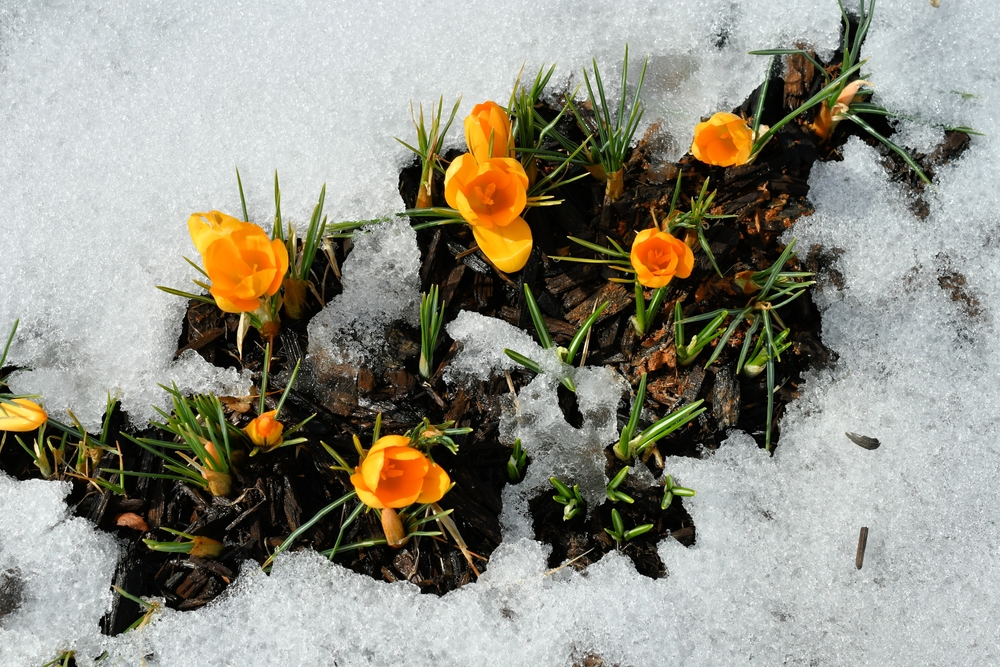
Image Source: Shutterstock.com
If you’ve ever looked outside in the middle of winter and thought everything in your garden is sleeping or dead, you’re only half right. Yes, some forms of life go dormant, but beneath that cold white blanket is a bustling world of hidden activity that absolutely depends on snow to survive the season. Snow isn’t just winter decoration—it’s a life-support system for soil organisms ranging from microbes to insects to plant roots waiting for spring.
The snowpack acts like a natural quilt, shielding the ground below from freezing winds and dehydration. Once you understand how this quiet, protective insulation works, snow becomes less of a nuisance and more of a superhero cape laid gently across the earth.
Snow Acts As Nature’s Blanket
Snow may look cold and uninviting on the surface, but its structure makes it surprisingly good at trapping heat. Each snowflake is full of tiny air pockets that lock in warmth and prevent the heat stored in the soil from escaping into the frigid winter air. Without snow, the soil would freeze much deeper and faster, endangering plant roots and microorganisms. Instead, the snow maintains temperatures just warm enough to keep life hanging on until spring. In this way, snow operates like a massive natural insulation layer, keeping the soil alive while everything above the surface shivers.
Soil Microbes Stay Active Under the Snow
One of the biggest surprises to many people is that soil microbes don’t simply shut down for winter. Beneath snow cover, they continue to break down organic matter, cycle nutrients, and support the soil ecosystem’s health. This slow, steady winter microbial work prepares the ground for spring growth long before the first thaw. Without snow protection, these microbes would freeze and die, leaving the soil far less fertile when the growing season returns. Snow ensures the microbial cities below continue running at a calm but productive pace.
Snow Prevents Harsh Freeze-Thaw Damage
Without consistent snow cover, the soil experiences sharp freeze-thaw cycles that cause real problems for soil stability and the life within it. When soil freezes, water inside expands; when it melts, it contracts, and these dramatic shifts can crush delicate fungal networks and disrupt root systems. Snow stabilizes temperatures and prevents these sudden swings, keeping the underground ecosystem steady. This stability allows roots, insects, seeds, and fungi to remain intact instead of being forced to endure constant destructive upheaval. The snowpack may look motionless, but it is actively preventing chaos beneath your feet.
Plants Rely On Snow For Winter Hydration
Snow doesn’t just protect soil life—it also slowly hydrates it. As snow melts, even in very small amounts throughout the winter, it provides a steady supply of moisture that keeps roots from drying out. Without this slow-release water source, many plants would suffer winter drought, even in cold climates. Snow ensures the soil retains just enough moisture for survival, acting almost like a drip irrigation system. Come spring, the meltwater continues to nourish plants as they awaken and stretch toward the returning sun.

Image Source: Shutterstock.com
Snow Protects The Homes Of Soil-Dwelling Creatures
Earthworms, beetles, spiders, and even hibernating frogs depend on the insulating effect of snow for survival. These creatures dig just deep enough to reach the warmer soil layers but rely on snow to prevent that layer from deep-freezing. If snow cover is absent, cold air can drive frost deep underground, freezing habitats that were never designed to handle those temperatures. The snow literally keeps entire communities from freezing solid. It’s like nature’s winter emergency housing program—soft, quiet, and vital.
Snow Helps Preserve Organic Matter Breakdown
Organic matter—like fallen leaves, plant stems, and roots—continues a slow decomposition process even in winter. Snow cover controls the pace of decomposition, allowing nutrients to be released gradually and evenly. This prevents nutrient surges that could wash away with melted water or be lost to erosion. The controlled breakdown enriches the soil steadily, preparing it for spring growth. Without snow, decomposition would be more erratic, less efficient, and far more vulnerable to nutrient loss.
Snow Reduces Wind Erosion And Soil Loss
Strong winter winds can strip exposed soil of valuable organic matter and nutrients, especially in open fields or prairies. Snow acts like a shield, holding the soil in place and preventing it from blowing away. The ground beneath stays intact and cohesive, maintaining the structure that plants and microbes depend on. This is especially important in agricultural regions, where soil health determines productivity. Snow isn’t just sitting there—it’s preventing the landscape from being literally torn away.
A World Of Life Quietly Waits For Spring Under Snow
When you picture winter soil life, don’t imagine emptiness. Picture tiny ecosystems resting, repairing, processing nutrients, and preparing for renewal. Snow cover ensures that this preparation can happen without interruption. The soil doesn’t die in winter—it resets, heals, and gathers strength. When spring arrives, the soil bursts forward with energy partly because snow protected every living layer of it.
The Silent Guardian Of Winter Soil
Snow may seem simple, but it performs one of the most important environmental roles of the winter season: protecting the intricate life below the surface. It shields microbes, roots, insects, and nutrients from harsh weather and dehydration, ensuring the soil remains lively and fertile for spring. The next time you see a snowy field or forest, imagine the bustling hidden world beneath, quietly depending on that cold white layer.
Snow isn’t just winter’s signature; it’s the soil’s quiet guardian. Have thoughts, questions, or a great snow-related story? Share it in the comments below.
You May Also Like…
8 Vines That Should Be Cut Back Before Snow
6 Wildflowers to Scatter Before the Snow Comes
How Cold Nights Improve Carrot Sweetness
6 Cold Weather Herbs That Keep Producing Indoors
8 Seeds That Germinate Better in Cold Soil
Leave a Reply